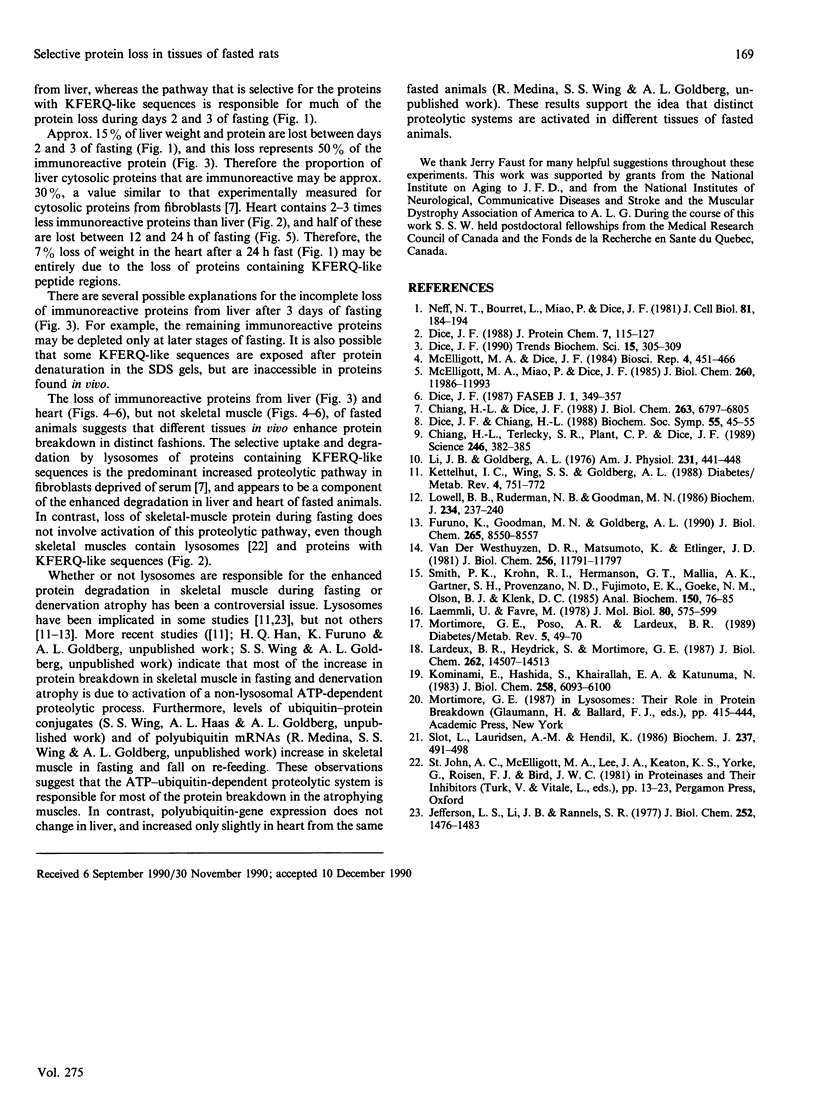Abstract
In response to serum withdrawal, when overall rates of proteolysis increase in cultured fibroblasts, proteins containing peptide regions similar to Lys-Phe-Gln-Arg-Gln (KFERQ) are targeted to lysosomes for degradation, and the intracellular concentrations of these proteins decline [Chiang & Dice (1988) J. Biol. Chem. 263, 6797-6805]. To test whether such proteins are also selectively depleted in mammalian tissues in vivo, we have used affinity-purified polyclonal antibodies to KFERQ to detect proteins containing such sequences in tissues of fed and fasted rats. Immunoreactive cytosolic proteins were partially depleted from liver and heart of fasted rats, but the time course differed for these two tissues. Immunoreactive proteins in liver were lost during days 2 and 3 of fasting, whereas such proteins in heart were depleted within day 1 of fasting. In the same fasted rats, levels of immunoreactive cytosolic proteins did not change in two skeletal muscles, the dark soleus and the pale extensor digitorum longus. Immunoreactive proteins in a myofibrillar fraction were also partially depleted in heart, but not in skeletal muscles, of fasted rats. The most likely explanation for these results is that the protein loss in different tissues upon fasting results from selective activation of different proteolytic pathways. The increased proteolysis in liver and heart of fasted animals includes activation of the KFERQ-selective lysosomal pathway, whereas increased proteolysis in skeletal muscle does not.
Full text
PDF




Images in this article
Selected References
These references are in PubMed. This may not be the complete list of references from this article.
- Chiang H. L., Dice J. F. Peptide sequences that target proteins for enhanced degradation during serum withdrawal. J Biol Chem. 1988 May 15;263(14):6797–6805. [PubMed] [Google Scholar]
- Chiang H. L., Terlecky S. R., Plant C. P., Dice J. F. A role for a 70-kilodalton heat shock protein in lysosomal degradation of intracellular proteins. Science. 1989 Oct 20;246(4928):382–385. doi: 10.1126/science.2799391. [DOI] [PubMed] [Google Scholar]
- Dice J. F., Chiang H. L. Peptide signals for protein degradation within lysosomes. Biochem Soc Symp. 1989;55:45–55. [PubMed] [Google Scholar]
- Dice J. F. Microinjected ribonuclease A as a probe for lysosomal pathways of intracellular protein degradation. J Protein Chem. 1988 Apr;7(2):115–127. doi: 10.1007/BF01025241. [DOI] [PubMed] [Google Scholar]
- Dice J. F. Molecular determinants of protein half-lives in eukaryotic cells. FASEB J. 1987 Nov;1(5):349–357. doi: 10.1096/fasebj.1.5.2824267. [DOI] [PubMed] [Google Scholar]
- Dice J. F. Peptide sequences that target cytosolic proteins for lysosomal proteolysis. Trends Biochem Sci. 1990 Aug;15(8):305–309. doi: 10.1016/0968-0004(90)90019-8. [DOI] [PubMed] [Google Scholar]
- Furuno K., Goodman M. N., Goldberg A. L. Role of different proteolytic systems in the degradation of muscle proteins during denervation atrophy. J Biol Chem. 1990 May 25;265(15):8550–8557. [PubMed] [Google Scholar]
- Jefferson L. S., Li J. B., Rannels S. R. Regulation by insulin of amino acid release and protein turnover in the perfused rat hemicorpus. J Biol Chem. 1977 Feb 25;252(4):1476–1483. [PubMed] [Google Scholar]
- Kettelhut I. C., Wing S. S., Goldberg A. L. Endocrine regulation of protein breakdown in skeletal muscle. Diabetes Metab Rev. 1988 Dec;4(8):751–772. doi: 10.1002/dmr.5610040805. [DOI] [PubMed] [Google Scholar]
- Kominami E., Hashida S., Khairallah E. A., Katunuma N. Sequestration of cytoplasmic enzymes in an autophagic vacuole-lysosomal system induced by injection of leupeptin. J Biol Chem. 1983 May 25;258(10):6093–6100. [PubMed] [Google Scholar]
- Laemmli U. K., Favre M. Maturation of the head of bacteriophage T4. I. DNA packaging events. J Mol Biol. 1973 Nov 15;80(4):575–599. doi: 10.1016/0022-2836(73)90198-8. [DOI] [PubMed] [Google Scholar]
- Lardeux B. R., Heydrick S. J., Mortimore G. E. RNA degradation in perfused rat liver as determined from the release of [14C]cytidine. J Biol Chem. 1987 Oct 25;262(30):14507–14513. [PubMed] [Google Scholar]
- Li J. B., Goldberg A. L. Effects of food deprivation on protein synthesis and degradation in rat skeletal muscles. Am J Physiol. 1976 Aug;231(2):441–448. doi: 10.1152/ajplegacy.1976.231.2.441. [DOI] [PubMed] [Google Scholar]
- Lowell B. B., Ruderman N. B., Goodman M. N. Evidence that lysosomes are not involved in the degradation of myofibrillar proteins in rat skeletal muscle. Biochem J. 1986 Feb 15;234(1):237–240. doi: 10.1042/bj2340237. [DOI] [PMC free article] [PubMed] [Google Scholar]
- McElligott M. A., Dice J. F. Microinjection of cultured cells using red-cell-mediated fusion and osmotic lysis of pinosomes: a review of methods and applications. Biosci Rep. 1984 Jun;4(6):451–466. doi: 10.1007/BF01122221. [DOI] [PubMed] [Google Scholar]
- McElligott M. A., Miao P., Dice J. F. Lysosomal degradation of ribonuclease A and ribonuclease S-protein microinjected into the cytosol of human fibroblasts. J Biol Chem. 1985 Oct 5;260(22):11986–11993. [PubMed] [Google Scholar]
- Mortimore G. E., Pösö A. R., Lardeux B. R. Mechanism and regulation of protein degradation in liver. Diabetes Metab Rev. 1989 Feb;5(1):49–70. doi: 10.1002/dmr.5610050105. [DOI] [PubMed] [Google Scholar]
- Neff N. T., Bourret L., Miao P., Dice J. F. Degradation of proteins microinjected into IMR-90 human diploid fibroblasts. J Cell Biol. 1981 Oct;91(1):184–194. doi: 10.1083/jcb.91.1.184. [DOI] [PMC free article] [PubMed] [Google Scholar]
- Slot L. A., Lauridsen A. M., Hendil K. B. Intracellular protein degradation in serum-deprived human fibroblasts. Biochem J. 1986 Jul 15;237(2):491–498. doi: 10.1042/bj2370491. [DOI] [PMC free article] [PubMed] [Google Scholar]
- Smith P. K., Krohn R. I., Hermanson G. T., Mallia A. K., Gartner F. H., Provenzano M. D., Fujimoto E. K., Goeke N. M., Olson B. J., Klenk D. C. Measurement of protein using bicinchoninic acid. Anal Biochem. 1985 Oct;150(1):76–85. doi: 10.1016/0003-2697(85)90442-7. [DOI] [PubMed] [Google Scholar]
- van der Westhuyzen D. R., Matsumoto K., Etlinger J. D. Easily releasable myofilaments from skeletal and cardiac muscles maintained in vitro. Role in myofibrillar assembly and turnover. J Biol Chem. 1981 Nov 25;256(22):11791–11797. [PubMed] [Google Scholar]



